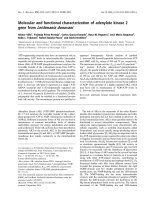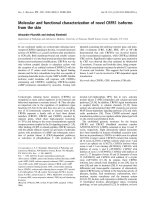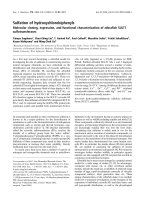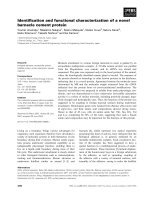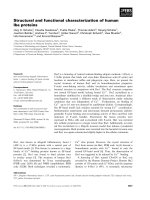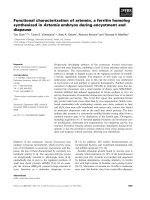Structural and functional characterization of TRX16, a thioredoxinlike protein and altering substrate specificity of a serine protease inhibitor
Bạn đang xem bản rút gọn của tài liệu. Xem và tải ngay bản đầy đủ của tài liệu tại đây (5.09 MB, 145 trang )
STRUCTURAL AND FUNCTIONAL CHARACTERIZATION OF
TRX16, A THIOREDOXIN-LIKE PROTEIN AND ALTERING
SUBSTRATE SPECIFICITY OF SPI1, A PROTEASE INHIBITOR
PANKAJ KUMAR GIRI
NATIONAL UNIVERSITY OF SINGAPORE
2011
STRUCTURAL AND FUNCTIONAL CHARACTERIZATION OF
TRX16, A THIOREDOXIN-LIKE PROTEIN AND ALTERING
SUBSTRATE SPECIFICITY OF SPI1, A PROTEASE INHIBITOR
PANKAJ KUMAR GIRI
A THESIS SUBMITTED
FOR
THE DEGREE OF DOCTOR OF PHILOSOPHY
DEPARTMENT OF BIOLOGICAL SCIENCES
NATIONAL UNIVERSITY OF SINGAPORE
2011
i
This thesis is dedicated to my inspiring parents
for their love, endless support
and encouragement
i
ACKNOWLEDGEMENT
No words can express the profound respect and gratitude I have for my
supervisors Prof. K Swaminathan and Prof. J. Sivaraman. I thank them for their
perpetual guidance, unceasing cooperation and constant encouragement, without which
this dissertation would have remained but a dream. They have not only led me with
utmost scholarliness, but also in full earnestness fostered my own initiative and
creativity. They have patiently guided me throughout the course and helped me
streamline my efforts effectively.
I express my heartfelt gratitude to Prof. Ding Jeak Ling, for her support and
encouragements. My special thanks to Dr. Gautam Sethi, Department of Pharmacology,
NUS and his postdoctoral fellow Dr. Shanmugam Muthu Kumaraswamy for helping in
ex-vivo studies based on HeLa cells for my project. I would like to thank Dr. Fan Jing-
Song, who helped me during my NMR data collection and structure solution for one of
my project.
I would like to convey my special thanks to Dr. Ping Yuan, Assistant professor, Li
Ka Shing Institute of Health Sciences, CUHK, Hong Kong for the opportunity she gave
me to work in her lab and for her guidance throughout my “Global research excellence
programme under the CNCOO Grant 2011”. I would like to thank Gan Jingyi and
LI Peng for their help and support during my stay in Hong Kong.
I would like to extend my thanks to all my colleagues and friends from SBL-4 and
5 for their full support and help. A special thanks to Lissa who helped all along my whole
duration of PhD. I want to thank friends Abdollah (NTU), Girish, Jack, Kang Wee,
ii
Karthik, Sang, Smarajit, Shifali, Toan (NTU), and Vamsi, who shared with me numerous
experiences and advice.
I am grateful to my parents and family members, whose constant inspiration,
persistent support and encouragement brought me to where I am now. I offer this thesis
as a humble tribute to all their love, affection and blessings, which they have showered
on me.
I thank NUS for giving me the opportunity to pursue my PhD with a research
scholarship.
“From small beginnings come great things…
… The distance does not matter. It’s only the first step that is difficult”
“Sometimes the journey is as exciting as the destination”
Pankaj Kumar Giri
November2011
iii
TABLE OF CONTENTS
ACKNOWLEDGEMENT i
TABLE OF CONTENTS iii
SUMMARY viii
LIST OF FIGURES xi
LIST OF TABLES xiv
LIST OF ABBREVIATIONS xv
LIST OF PUBLICATIONS xviii
CHAPTER-I: GENERAL INTRODUCTION 1
1.1 REACTIVE OXYGEN SPECIES (ROS) 2
1.2 THIOREDOXIN SYSTEM 8
1.2.1 Phylogenetic analysis of Thioredoxin (Trx) 10
1.2.2 Biological roles of thioredoxin system 14
1.2.3 Carcinoscorpius rotundicauda thioredoxin related protein 16 17
1.2.4 The influence of Cr-TRP16 in NF-κB signaling pathway 18
1.3 PROTEIN DESIGN AND ENGINEERING 21
1.3.1 Directed evolution strategies 22
1.3.2 Rational redesign strategies 23
1.3.3 Rational design and engineering of therapeutic proteins 24
1.3.4 Structure-based design of altered specificity 29
iv
1.4 OBJECTIVES 35
CHAPTER-II: NMR STRUCTURE OF carcinoscorpius rotundicauda
THIOREDOXIN-RELATED PROTEIN 16 AND ITS ROLE IN REGULATING NF-KB
ACTIVITY 36
2.1 INTRODUCTION 36
2.2 EXPERIMENTAL PROCEDURES 39
2.2.1 Cloning 39
2.2.2 Protein expression and purification 39
2.2.3 NMR experiments and structure determination 40
2.2.4 Site-directed mutagenesis 41
2.2.5 Analytical Ultra Centrifugation (AUC) 41
2.2.6 Western blotting 42
2.2.7 NF-B DNA binding assay 42
2.2.8 NF-κB dependent luciferase reporter assay 43
2.3 RESULTS 43
2.3.1 Purification of recombinant Cr-TRP16 43
2.3.2 Overall structure 45
2.3.3 Sequence and structural homology 47
2.3.4 Dimerization of Cr-TRP16 51
2.3.5
1
H-
15
N-HSQC NMR spectroscopy 51
v
2.3.6 Analytical ultracentrifugation (AUC) 54
2.3.7 Cr-TRP16 increases TNF- induced nuclear translocation of p65 and p5057
2.3.8 Cr-TRP16 augments TNF- induced NF-B DNA binding activity 59
2.3.9 Cr-TRP16 augments TNF- induced NF-B-dependent reporter gene
expression 60
2.4 DISCUSSION 63
CHAPTER-III: CHARACTERIZATION OF HUMAN THIOREDOXIN LIKE
PROTEIN-6 (TXNL-6) 66
3.1 INTRODUCTION 66
3.2 RESULTS AND DISCUSSION 68
3.2.1 Cloning 68
3.2.2 Protein expression and purification 68
3.2.3 In vitro interaction between TXNL-6 and NF-kB 72
3.2.4 Crystallization of TXNL-6 and its complex with NF-kB-p50 79
CHAPTER-IV: MODIFYING THE SUBSTRATE SECIFICITY OF Carcinoscorpius
rotundicauda SERINE PROTEASE INHIBITOR DOMAIMN 1 TO TARGET
THROMBIN 80
4.1 INTRODUCTION 80
4.2 EXPERIMENTAL PROCEDURES 82
4.2.1 Plasmid and strain construction 82
vi
4.2.2 Expression and Purification 82
4.2.3 Crystallization and structure determination 83
4.2.4 Site-directed mutagenesis 84
4.2.5 CD spectroscopy 84
4.2.6 Stability verification of CrSPI-1-D1 mutants against serine proteases 85
4.2.7 Inhibition of Thrombin Amidolytic Activity 85
4.2.8 Isothermal Titration Calorimetry (ITC) 86
4.3 RESULTS 86
4.3.1 Overall structure 86
4.3.2 Structural comparison 87
4.3.3 The reactive-site loop 91
4.3.4 Mutations to change the specificity 94
4.3.5 Thrombin inhibition assay 100
4.3.6 Isothermal Titration Calorimetry (ITC) studies 104
CHAPTER-V: CONCLUSION AND FUTURE DIRECTION 109
5.1 CONCLUSIONS 109
5.1.1 Cr-TRP16 and its role in NF-kB signaling pathways 109
5.1.2 Modifying the substrate specificity of a Cr inhibitor to target thrombin 109
5.2 FUTURE DIRECTION 110
vii
5.2.1 Structural insights into the mechanism of TXNL-6 / NF-κB complex in
protection of human photoreceptor cells from photo oxidative damage 110
5.2.2 Development of smaller and less immunogenic potent thrombin inhibitor
111
BIBLIOGRAPHY xix
viii
SUMMARY
The causative agents of most diseases like cancer and Alzheimer’s are proteins.
The function of a protein can be fully appreciated only when we have a complete
knowledge of its 3-dimensional structure, as structure and function go hand in hand.
Decades of effort using X-ray crystallography and NMR have produced thousands of
protein and complex with binding partner structures and these structures provide a rich
source of data for learning the principles of how proteins interact and for rational design
and engineering of therapeutics. Here, we are particularly keen on figuring out how
proteins are involved in gene regulation under stress by interacting with their partners and
the use of a rational approach for protein design and engineering to change the substrate
specificity of a protease inhibitor.
This PhD thesis consists of five chapters. Chapter I deals with the literature
survey and general introduction about the thioredoxin (Trx) system (an antioxidant) and
briefly covers the various strategies of structure based protein design and engineering to
develop drugs against a specific protease inhibitor. Chapter II deals with the structural
and functional characterization of thioredoxin like protein 16 from Carcinoscorpius
rotundicauda (Cr-TRP16), a 16 kDa Trx-like protein that contains a WCPPC motif. We
present the NMR structure of the reduced form of Cr-TRP16, along with its regulation of
NF-κB activity. Unlike other 16 kDa Trx-like proteins, Cr-TRP16 contains an additional
Cys residue (Cys15, at the N-terminus), through which it forms a homo-dimer. Moreover
we have explored the molecular basis of Cr-TRP16 mediated activation of NF-κB in the
HeLa cell and show that Cr-TRP16 exists as a dimer under an oxidized condition and
only the dimeric form binds to NF-κB and enhances its DNA-binding activity by directly
ix
reducing the cysteines in the DNA-binding motif of NF-κB. The C15S mutant of Cr-
TRP16 is unable to dimerize and hence does not bind to NF-κB.
Based on our finding and combined with the literature, we propose a model on
how Cr-TRP16 is likely to bind to NF-κB. These findings elucidate the molecular
mechanism by which NF-κB activation is regulated by Cr-TRP16. Chapter III reports the
expression and purification of human thioredoxin like protein-6 (TXNL-6), a homolog of
Cr-TRP16 and protects retinal cells from apoptosis under stress and characterization of its
interaction with NF-kB.
Chapter IV presents the structure based rational design of altered specificity of a
protease inhibitor. Protease inhibitors play a decisive role in maintaining homeostasis and
eliciting antimicrobial activities. Invertebrates like horseshoe crab have developed unique
modalities with serine protease inhibitors to detect and respond to microbial and host
proteases. Two isoforms of immunomodulatory two-domain Kazal-like serine protease
inhibitors, CrSPI-1 and CrSPI-2, have been recently identified in the hepatopancreas of
the horseshoe crab, Carcinoscorpius rotundicauda. Full length and domain 2 of CrSPI-1
display powerful inhibitory activities against subtilisin. However the structure and
function of CrSPI-1 domain-1 remain unknown. Here, we report the crystal structure of
CrSPI-1-D1, refined at 2.0 Å resolution. Despite the close structural homology of CrSPI-
1-D1 to rhodniin-D1 (a known thrombin inhibitor), CrSPI-1-D1 does not inhibit
thrombin. This prompted us to modify the selectivity of CrSPI-1-D1, specifically towards
thrombin. Here, we illustrate the use of the structural information of CrSPI-1-D1 to
modify this domain into a potent thrombin inhibitor with IC
50
of 26.3 nM. In addition,
these studies demonstrate that besides the rigid conformation of the reactive site loop of
x
the inhibitor, the sequence is the most important determinant of the specificity of the
inhibitor. This study will lead to significant applications to modify a multi-domain
inhibitor protein to target several proteases. Chapter V provides the overall conclusion
and future directions of these projects.
xi
LIST OF FIGURES
Figure 1.1: Cellular sources of ROS in living cells 3
Figure 1.2: Schematic representation of various activators and inhibitors of reactive
oxygen species production 4
Figure 1.3: Reactive oxygen species (ROS)-induced oxidative damage 6
Figure 1.4: O2- is converted into H2O2 by superoxide dismutases (SODs). 8
Figure 1.5: Redox reactions catalyzed by a mammalian Trx system comprising
thioredoxin reductase (TrxR), thioredoxin (Trx) and NADPH 8
Figure 1.6: The three-dimensional structure of E. coli thioredoxin 10
Figure 1.7: Amino acid sequence comparison among thioredoxins from different species.
13
Figure 1.8: Biological roles of the thioredoxin system 15
Figure 1.9: Comparison of CXXC motif, numbers and positions of cysteine residues in
various Trxs. 17
Figure 1.10: Activation of NF-κB signaling pathway involves Trx 20
Figure 1.11: Various strategies for protein design and engineering 22
Figure 2.1: FPLC profile of Cr-TRP16 45
Figure 2.2: Dynamic light scattering (DLS) profile of Cr-TRP16 45
Figure 2.3: Structure of Cr-TRP16 46
Figure 2.4: The topology diagram of Cr-TRP16. 47
Figure 2.5: Comparison of Cr-TRP16 with Trypaerdoxin 50
Figure 2.6: Superposition of 1H-15N HSQC spectra of oxidized and reduced wild type
Cr-TRP16. 53
xii
Figure 2.7: Study of the dimerization of Cr-TRP16 by sedimentation velocity analysis
56
Figure 2.8: Effect of Cr-TRP16 on the expression and subcellular localization of NF-κB
58
Figure 2.9: TNFα induced NF-κB DNA-binding activity 60
Figure 2.10: Model for the interaction of Cr-TRP16 dimer with NF-κB dimer. 62
Figure 3.1: Gel filtration profile of purified TXNL-6. 69
Figure 3.2: SERp predicted surface exposed charged residues clusters. 71
Figure 3.3: FPLC profile of TXNL-6 after surface exposed mutagenesis 72
Figure 3.4: Dynamic light scattering (DLS) profile of mutated TXNL-6 73
Figure 3.5: The FPLC profile of NF-κB (43-244). 74
Figure 3.6: FPLC profile of TXNL6 and NF-κB p50 complex protein. 76
Figure 3.7: In vitro interaction between TXNL6 and NF-κB p50 subunit (non-reducing
SDS-PAGE) 77
Figure 3.8: Identification of TXNL6 and NF-κB p50 elution peak by peptide mass
fingerprint 78
Figure 4.1: Structure of CrSPI-1-D1 87
Figure 4.2: Comparison of CrSPI-1-D1 with rhodniin-D1. 90
Figure 4.3: The reactive-site loop (RSL) 93
Figure 4.4.5: Modeling complex of CrSPI-1-D1 with thrombin. 96
Figure 4.5: Reverse Phase-HPLC profile of CrSPI-1-D1 97
Figure 4.6: CD spectroscopy profile of reverse phase HPLC purified CrSPI-1-D1 98
xiii
Figure 4.7: The specificity of CrSPI-1-D1 tetra mutant for thrombin ascertained by
comparison with other proteases. 100
Figure 4.8: Determination of IC50 values based on dose response plots of fractional
velocity as a function of different tetra mutant CrSPI-1-D1 concentration. 101
Figure 4.9: ESI/MS profile of reverse phase HPLC purified CrSPI-1-D1. T 102
Figure 4.10: Concenration dependent Inhibition of α-human thrombin by CrSPI1-D1 and
its mutant: 103
Figure 4.11: Isothermal Titration Calorimetry analysis. 104
xiv
LIST OF TABLES
Table 1.1: A partial list of diseases that have been linked to reactive oxygen species. 5
Table 1.2: Homology (in percentage*) among thioredoxins from different species 12
Table 1.3: The biophysical properties of proteins that can be optimized to obtain desired
therapeutic outcomes 25
Table 1.4: Some examples of protein engineering. 26
Table 1.5: Engineered protein therapeutics on the market 28
Table 1.6: Examples of successful strategies applied for the design and development of
serine protease inhibitors 34
Table 2.1: NMR data and structure determination details for reduced Cr-TRP16 48
Table 4.1: Data collection and refinement statistics of CrSPI-1-D1 89
Table 4.2: Interaction involved for rigidity of reactive site loop of CrSPI-1-D1 92
Table 4.3: Reactive site loop regions from P3 to P4’ position of selected serine protease
inhibitors 95
Table 4.4: IC
50
and dissociation constant (Kd) for the inhibition of thrombin by various
variants of CrSPI-1-D1 99
xv
LIST OF ABBREVIATIONS
AA
Amino acids
A600/595
Absorbance at 600/595 nm
ATP
2’-deoxyadenosine 5’-triphosphate
bp
Base pair
BSA
Bovine serum albumin
cDNA
Complementary deoxyribonucleic acid
CD
Circular Dichroism
Cr
Carcinoscropius rotundicauda
Cr-SPI-1
Carcinoscorpius rotundicauda serine protease
Cr-TRP16
Carcinoscropius rotundicauda TRX1 (16 kDa)
DMSO
Dimethyl sulfoxide
DNA
Deoxyribonucleic acid
DTT
Dithiothreitol
DLS
Dynamic Light Scattering
E. coli
Escherichia Coli
EDTA
Ethylenediaminetetraacetic acid
EMSA
Electrophoretic mobility shift assay
Fig
Figure
FPLC
Fast Protein Liquid Chromatography
β-Gal
β−galactosidase
GSH
Glutathione
GST
Glutathione S-transferase
h
Hour
HSQC
Heteronuclear Single Quantum Correlation
IKK
Inhibitory κB kinase
iNOS
Inducible nitric oxide synthase
ITC
Isothermal Titration Calorimetry
Ka
Association constant
kb
Kilobase
Kd
Dissociation constant
kDa
Kilodalton
LB
Luria Bertani
xvi
LUC
Luciferase
mg
Milligram
min
Minute
ml
Milliliter
mM
Millimolar
MALDI-TOF
Matrix-assisted laser desorption ionization-Time of flight
mRNA
Messenger ribonucleic acid
NEB
New England Biolabs
NF-κB
Nuclear factor-κB
ng
Nanogram
NIK
NF-κB inducing kinase
Ni-NTA
Nickel nitrilo-triacetic acid
NLS
Nuclear localization signal
nM
Nanomolar
NMR
Nuclear Magnetic Resonance
NOE
Nuclear Overhauser Effect
NOESY
Nuclear Overhauser Enhancement Spectroscopy
OD
Optical density
ORF
Open reading frame
PAGE
Polyacrylamide gel electrophoresis
PBS
Phosphate buffered saline
PCR
Polymerase chain reaction
PDB
Protein Data Bank
PEG
polyethylene glycol
ppm
Parts per million
RdCVF
Rod-derived cone viability factor
RF
Radio Frequency
rmsd
Root mean square deviation
RNA
Ribonucleic acid
RNase
Ribonuclease
ROS
Reactive oxygen species
rpm
Revolutions per minute
RT-PCR
Reverse transcriptase-polymerase chain reaction
SDS
Sodium dodecyl sulphate
xvii
SDS-PAGE
Sodium dodecyl sulfate - polyacrylamide gel electrophoresis
s
Second
T
Thymine
T1
Longitudinal relaxation
T2
Transverse relaxation
TD
Transactivation domain
TLR
Toll-like receptor
TOCSY
Total Correlation Spectroscopy
TNFα
Tumor necrosis factor α
Trx
Thioredoxin
TrxR
Thioredoxin reductase
TRNOE
Transferred Nuclear Overhauser Effect
TXNL-6
Thioredoxin-like 6 (Human 24 kDa TRX)
U
Unit
UV
Ultraviolet
V
Volt
v/v
Volume : volume ratio
w/v
Weight : volume ratio
xviii
LIST OF PUBLICATIONS
Giri P.K., Song FJ, Shanmugam MK,Ding JL,Sethi G, Swaminathan K, Sivaraman J
(2011) (submitted) NMR structure of Carcinoscorpius rotundicauda thioredoxin-related
protein 16 and its role in regulating transcription factor NF-kB activity.JBC
Giri P.K., Tang X, Thangamani S, Shenoy RT, Ding JL, Swaminathan K, Sivaraman J
(2010) Modifying the substrate specificity of Carcinoscorpius rotundicauda serine
protease inhibitor domain 1 to target thrombin. PLoS One 5: e15258
1
CHAPTER-I: GENERAL INTRODUCTION
esearch in its highest expression,
is an open-minded expression inquiry; for truth,
to be found and revealed unreservedly,
for the information, instruction, advantage and welfare of ALL”
…… Williams J Gies
Aerobic life depends upon controlled combustion for energy supply. Controlled
combustion is catalyzed and regulated by metabolic machinery that can be damaged by
uncontrolled oxidative reactions that are associated with energy production. Due to the
extreme threat of such uncontrolled oxidation, aerobic life evolved a complex set of
antioxidant systems to control these reactions and repair or replace the damaged
machinery. At the same time, enzyme systems evolved to produce reactive species for
biological signaling, biosynthetic reactions, chemical defense, and detoxification
functions. The presence of both toxic and beneficial consequences of reactive species
precludes a simple definition of oxidative stress.
The following sections will present a general introduction about the thioredoxin
system (an antioxidant) in the first part, while the second part briefly covers the various
strategies of structure based protein design and engineering to develop drugs against
specific protease inhibitors.
“R
2
1.1 REACTIVE OXYGEN SPECIES (ROS)
Reactive oxygen species (ROS) is a collective term that describes the chemical
species that are formed upon incomplete reduction of oxygen and includes the superoxide
anion (O2–), hydrogen peroxide (H2O2) and the hydroxyl radical (HO). ROS are thought to
mediate the toxicity of oxygen because of their greater chemical reactivity with regard to
oxygen. Reactive oxygen species are highly reactive due to the presence of unpaired
valence shell electrons. ROS are formed as a natural byproduct of the normal metabolism
of oxygen and have important roles in cell signaling and homeostasis (Flohé et al., 1997;
Novo and Parola, 2008; Quinn et al., 2002). Fig. 1.1 illustrates the mechanisms for the
generation of ROS in living cells.
At the cellular level, ROS may act as second messengers in various signal
transduction and elicit a wide spectrum of responses ranging from proliferation to growth
or differentiation arrest, to senescence, to cell death by activating numerous major
signaling pathways including phosphoinositide 3-kinase (PI-3K), NF-κB, phospholipase
C-γ1 (PLC- γ1), p53, CREB, HSF and mitogen-activated protein kinases [MAPKs, which
may classify into: extracellular signal-regulated kinases (ERKs), c-Jun N-terminal (JNK),
p38 MAPK]. The magnitude and duration of the stress, as well as the cell type involved,
are important factors in determining which pathways are activated and the particular
outcome reflects the balance between these pathways (Martindale and Holbrook, 2002).
3
Figure I.1: Cellular sources of ROS in living cells. Adopted from(Novo
and Parola, 2008).
4
The continuous efflux of ROS from endogenous and exogenous sources results in
continuous and accumulative oxidative damage to cellular components (Comporti, 1989)
and alters many cellular functions (Gracy et al., 1999). Among the biological targets most
vulnerable to oxidative damage are proteinaceous enzymes (Davies et al., 1987; Levine
and Stadtman, 2001), lipidic membranes (Davies et al., 1987), and DNA (Beckman and
Ames, 1997; Chang et al., 2007) (Fig. 1.2).
Figure I.2: Schematic representation of various activators and inhibitors
of reactive oxygen species production. Adopted from (Reuter et al., 2010).
Numerous pathologies and disease states serve as sources for the continuous
production of ROS (Baud and Ardaillou, 1986; Halliwell, 1994; Kawanishi et al., 2002;
Levy, 1996; Venditti et al., 2002). More than 200 clinical disorders have been described
in the literature in which ROS were important for the initiation stage of a disease or


